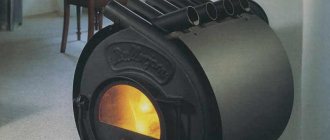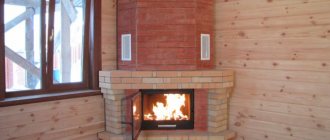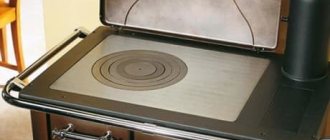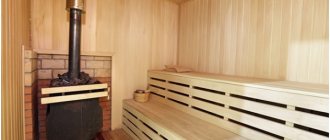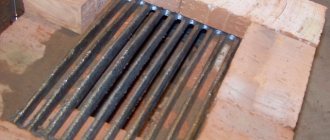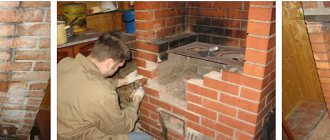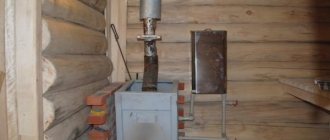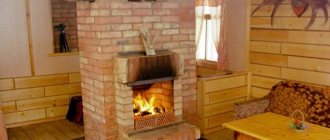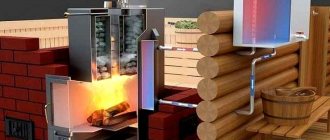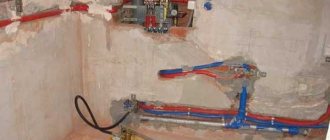How to install Buleryan? Installation of the Buleryan stove
Installing a Buleryan stove is not such a complicated procedure. Knowing the basic installation requirements, any man can cope with this task.
This article presents the basic requirements for installing a buleryan: how to make a chimney, what distance the stove should be from the walls and other safety rules.
So, to install Buleryan you will need:
stand (factory or self-made)
The stand for installing the buleryan is purchased based on the type of stove.
A stand under the Buleryan stove is necessary to ensure good air circulation in the room, which promotes convection and, accordingly, rapid heating.
The stand for the buleryan can be ordered directly from the factory where the heating device is produced, or it can be installed on your own base, for example made of brick.
A metal sheet is needed for the safe operation of the buller. The sheet is laid in front of the door if the floor of the room where the buleryan is installed is wooden or made of other flammable materials.
It is allowed to install buleryan on a tiled or stone floor without using a sheet.
Chimney for buleryan - the main installation factor
The most important element, without which the Buleryan boiler will not be able to work properly, is the chimney.
The chimney for a buleryan must be metal. It is impossible to connect a long-burning stove to a rough or brick chimney without a preliminary liner.
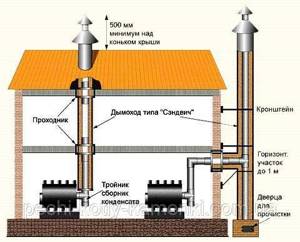
Why does a buleryan need a metal chimney?
Since the calorific stove is a long-burning unit and the bulk of the thermal energy is spent on heating the air, the temperature of the flue gases at the outlet of the stove is much lower than in simple potbelly stoves. This smoke temperature cannot warm up a brick chimney or chimney, resulting in condensation. Condensation in the chimney is the beginning of contamination of the pipe, and therefore a deterioration in draft.
Draft is very important for this type of stove. Only a straight metal chimney, well insulated on the street, the height of which is not lower than the ridge, can provide good draft for the buleryan.
Only such a chimney design will allow the long-burning buleryan to be used without problems with draft, without smoke and reverse draft.
Installing a stove using a stainless chimney is the best solution.
Stainless steel of acid-resistant grades AISI 304, 321 is durable: it is resistant to corrosion and aggressive acids. A stainless steel chimney is usually modular. A modular chimney consists of individual parts that are easy to install and fit into one another. To lay the pipe outdoors, a sandwich chimney is used - a pipe in a casing with thermal insulation.
Basic rules for correct installation of Buleryan:
- the stove must be located at a distance of 1 meter from walls made of flammable material. If the wall is plastered, then the distance can be reduced to 0.5 meters.
- For safe installation of the chimney to the Buleryan boiler, it is necessary to provide a non-combustible ceiling cut - penetration through the ceiling.
- To prevent moisture from entering the house, the outlet of the pipe on the roof is sealed with a roof or a flash master.
- the height of the chimney should rise above the roof ridge by 0.5 meters (in certain cases the height may be less).
- The outer section of the chimney is laid with sandwich elements (insulated thermal pipes).
- It is imperative to provide an element for collecting ash - an inspection, a tee.
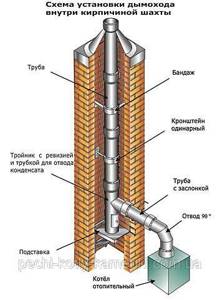
By fulfilling all of the above requirements and recommendations for installing a buleryan, you can achieve trouble-free operation of the wood-burning heating system.
How to properly install Buleryan in a house, garage, greenhouse, installation of a chimney can be found in the Ochag online store.
How to set up PS4 and router to make PSN work faster

A lot of people complain about the speed of PSN. We have said many times that Sony's network services in general leave much to be desired (especially billing, which often works at times). But all is not lost. After dancing with a tambourine, you can force your PS4 to download games from PSN quite quickly, and also not have problems joining friends on the server. All these tips helped me specifically, and perhaps they will help you too.
This guide was written after experimenting with routers and consoles over the past seven years, since I had to set up connections for Xbox 360, PS3, PS Vita, Apple TV, torrent clients, and so on. All the information was gleaned from a bunch of completely open sources, it is not new, but as usual, we decided to chew it all up and collect it in one place. Let's go in order.
Connect PS4 via WiFi or wired
Let's accept it as an unpleasant but inevitable truth that all PS4s except PS4 Slim and PS4 Pro have WiFi modules that are no good. On paper, the new iterations of the PS4 will have completely different WiFi modules (with support for 5 GHz and 802.11ac), but in fact we’ll see.
From here we draw the main conclusion: if you want your PS4 to download data from PSN really quickly, then you will most likely have to connect the console to the router directly with a wire.
Setting up PS4 for PSN to work properly
Everything is very simple. You need to go to the network connection settings in PS4, select a wired connection there, and then select the simple setup mode.
Setting up a router for PSN: NAT
So, you have connected the PS4 to the router directly with a wire. Now you need to configure the router itself for proper data routing.
The first thing to do is to find the UPNP option in the WAN / LAN settings. In 90% of cases it is enabled by default, but suddenly you find yourself in that same 10%? So feel free to turn it on and move on.
Around the same place there may be an option about selecting the type of routing, so you need to enable UPNP, NAT-PMP, PCP.
It is quite possible that your router supports modern NAT acceleration methods. For example, Asus routers have this option, it’s worth turning it on. It’s called Accelerate NAT, where you need to ensure that offloading occurs on all fronts, that is, you should enable Offload TCP/UDP for LAN/WLAN. In addition, if there is an option “Not only to your IP”, then it also needs to be enabled.
Setting up a router for PSN: static IP and DMZ
Next, go to the WAN / LAN settings, there you need to find the DHCP section. It allows you to assign a specific IP address to a specific device within your local network. Find the PS4 there (or its MAC address, you can check it inside the PS4 itself in the network connection information) and assign it a static address like XXX.XXX.XXX.XXX, for example, 192.168.1.55 (if your router distributes via DHCP pool of addresses like 192.168.1.XXX).
The next step is usually optional, but would definitely be helpful. You need to find the DMZ (demilitarized zone) setting in the router and put the static IP address you just assigned to the PS4 there. Usually routers allow you to define only one IP address in the DMZ, I advise you to put the PS4 there.
Setting up a router for PSN: port forwarding
This is one of the most important points in setup. You need to go to the WAN / LAN settings, find the option for port forwarding there. There you now need to do the following: to the just assigned static IP address of your PS4, register certain ports that will be redirected, bypassing processing inside the router.
So, we need the following ports: TCP 80, 443, 1935, 3478, 3479, 3480, 9295
UDP
3478, 3479, 9296, 9297, 9303
Ports 9xxx are needed for correct and correct operation of Remote Play over the Internet. The fact is that this function may just work fine for you, but there are no guarantees, as is usually the case with the PS4. But with these open ports, your chances improve!
Setting up a router for PSN: DNS
Often many problems with PSN, including poor speed and inability to connect to group chats, can be solved by changing the DNS to others. Many people use their DNS provider, which they provide automatically, some use Google DNS. But if for some reason your provider is not working well, and its DNS periodically falls off or is updated slowly, then you should use a radical method. Install SkyDNS. Dima Zombak recommended it to me, it helped him solve many problems with PSN at once.
Just find the DNS setting in the WAN / LAN sections of the router and enter the address 193.58.251.251 there. SkyDNS updates its tables quite quickly, so your console will be able to move more efficiently from server to PSN server, without being limited to an outdated set of addresses that may already have disconnected servers.
Gas generator stove for a dacha Buleryan (Bullerjan)
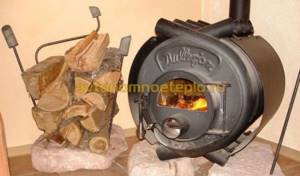
- Content:
- Is it possible to heat a dacha with Buleryan Convection heating
- Heating a summer house with air ducts
- Possibility of cooking
To select suitable heating equipment for a summer residence, it is necessary to take into account several important requirements related to the features of operation and heating of a country house. The Bullerjan dacha stove fully meets all requirements: with its help you can quickly warm up an unheated building, cook food and heat water. With all these advantages, the stove is capable of operating in gas generation mode for 6 hours from one load of firewood.
Is it possible to heat a dacha with Buleryan
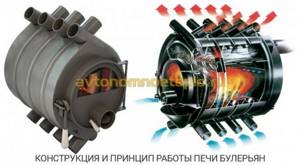
Convection heating
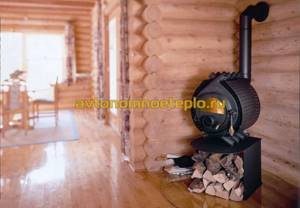
Installing a Buleryan solid fuel stove at the dacha has certain disadvantages:
- Any obstacles in the way of convection currents reduce the thermal efficiency of the oven.
- Without additional structural changes, there is no possibility of heating adjacent rooms located on different floors or separated by walls.
Heating directly from the stove for heating a long-burning dacha Buleryan is suitable for owners of small houses. If you plan to heat a building that has many rooms that are not on the same floor, you will need to modify the design by connecting air ducts to convection pipes.
Heating a summer house with air ducts
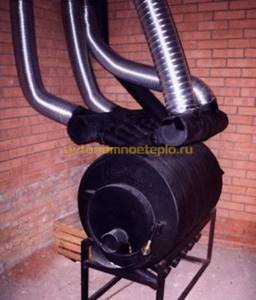
To heat a 2-story country house, it will not be enough to install a gas generator stove in the building. Additionally, air ducts are connected to the convection pipes. Installation is carried out as follows:
- A special collector is installed on the convection pipes.
- The required number of air ducts are connected to the outlets located on the manifold of the air heating system of a two-story dacha using a Buleryan stove.
- The pipes are led into heated rooms and installed as low as possible to the floor level. A separate heated air supply hose is used for each room.
- The stove is installed in a separate room with sufficient ventilation.
Wood-burning pyrolysis stoves for the Buleryan dacha, with connected air ducts, are used to heat a building with several rooms and floors. The modified system manages to eliminate the shortcomings of convection equipment and increase heat transfer.
Possibility of cooking
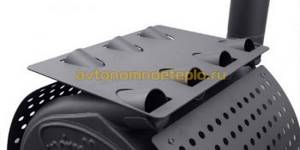
Models with a hob installed on top are designed for this purpose. The oven has enough power to heat 6 liters of water to a boil in about 15-20 minutes. Buleryan with a hob is available in several versions, differing in the number of burners. For convenience, it is better to use a two-burner model. Heating and cooking is carried out in normal combustion mode.
Conclusion
The advantages of the Buleryan stove over other sources are obvious:
- high efficiency (about 80%)
- increased fuel combustion time and, as a result, its savings
- small overall dimensions
- does not require a complex chimney system
- can be installed independently after building the house
- quite high power
- fast heat transfer
But there are also disadvantages:
- Works only on solid fuel. Liquid and gas cannot be used.
- Unable to accumulate and accumulate heat, warm air will flow into the room until the stove burns out. Then you will need to add fuel again.
- Relatively high cost.
The Buleryan convection oven should be used when:
- You are not present at the dacha all the time;
- You need heating from time to time;
- You need to heat a cold room as quickly as possible.
Buleryan will cope with these tasks successfully. A convection oven can heat a spacious room, as well as several neighboring ones. It will be very useful for heating a warehouse, greenhouse, bathhouse, barn.
It is better to purchase a German-assembled factory version. It is quite reliable, safe and aesthetically pleasing. Thick metal will not burn out and will last for decades. An economical version of such a stove can be made independently.
The heating system is quite competitive in the harshest climatic conditions. Thanks to fuel economy and high efficiency, it does not require large operating costs.
Related Posts
- Buleryan oven: do it yourself
- Wood-burning stoves and their variety of designs
- Fire-battery 7b (thermophor)
- How to make a long-burning stove yourself
- How to choose a stove for an Ermak sauna: top 7 models with descriptions of technical characteristics and customer reviews
- A stove with a water circuit for heating a house: features of stove heating + choosing the optimal option
- How to fold a Swedish oven with a stove
- DIY metal rocket oven
- Do-it-yourself gas heater: options for the best homemade products
- Cast iron stove for bath Vesuvius
- Homemade Russian stove on the street under a canopy
- Fast and correct furnace repair
- Types and sizes of Russian stoves: types, sizes, 5 construction recommendations
- Secrets of stove makers: brick stove for a bath
- How to install a stove in the house?
- Stove heating in a private house
- Manufacturing and connecting a sauna stove with a water heat exchanger
- Types of Kuznetsov furnaces and their order
- How to weld a metal sauna stove
- Solid fuel stove Professor Butakov engineer
- Installing a stove in a steam room: location, fencing, protective screen
- Breneran Aqua stoves with a water circuit: operating principle and operating nuances, brief description of models
- Fireplace stove with water heating circuit: selection and self-installation
- Types of stoves for the home: classification and review of equipment from the best manufacturers
- Do-it-yourself heating options for a country house
Read with this
- Buleryan oven: do it yourself
- Wood-burning stoves and their variety of designs
- Fire-battery 7b (thermophor)
- How to make a long-burning stove yourself
- How to choose a stove for an Ermak sauna: top 7 models with descriptions of technical characteristics and customer reviews
- A stove with a water circuit for heating a house: features of stove heating + choosing the optimal option
- How to fold a Swedish oven with a stove
- DIY metal rocket oven
- Do-it-yourself gas heater: options for the best homemade products
- Cast iron stove for bath Vesuvius
Heating a greenhouse with Buleryan
Reviews and experience in the practical use of Buleryan in a greenhouse prove that a gas-generating furnace is optimally suited for heating. But you will need to take care to comply with some measures that increase productivity and ensure safety.
The ability to maintain the required temperature in gas generation mode is especially necessary when heating a greenhouse in winter. One stack of firewood is enough to ensure uninterrupted operation for at least 6 hours.

It is important to ensure unhindered air convection in the greenhouse when heating with a Buleryan heat generator. The heating efficiency of the furnace is reduced if air flow is obstructed by partitions or other obstructions.
How to properly install Buleryan at the dacha
Design features allow Buleryan to be refined after installation in a wooden country house. The stove is lined with ceramic bricks. At the same time, heat transfer and energy efficiency remain at the same level, but a protective frame appears that prevents burns.
Some models are equipped with a door with a heat-resistant glass insert. After facing with brickwork, it will be possible to admire the fire during the combustion process.
Pros and cons of heating a dacha with Buleryan
When choosing heating equipment for your dacha, you will need to take into account both the advantages and disadvantages of various boilers and stoves that burn solid fuel. To make the right decision, you should consider the thermal characteristics of various types of heating devices.
What is better for a dacha - Buleryan or Butakov stove
The main difference between the Buleryan and Butakov stoves is the design of the convection tubes. In Buleryanov, the pipes come out of the body, which allows you to connect the equipment of the air heating system of several rooms of the dacha with a stove, without significant modifications or changes in design. Butakov’s convection outlets are located inside the body.
Design features of modern potbelly stoves
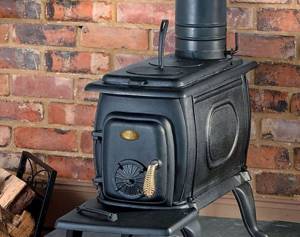
There is no point in describing ancient potbelly stoves, so we will reveal the secrets of the functionality of modern heating elements of this type. What increased their effectiveness?
Cladding made of heat-resistant materials. As before, the firebox of the device is made of cast iron or steel, it heats up instantly, and to slow down the cooling process, the inventors used a heat-resistant finish. The inside of the fuel combustion container was lined with fireclay plates, thanks to which the heat is retained longer.
Afterburning The vaults in today's potbelly stoves are quite high, which makes it possible to install a system of so-called gas re-combustion in them. This increases efficiency and significantly reduces the temperature of combustion products exiting the pipe.
Slow combustion.
The firebox doors are equipped with a seal that provides a tight seal, which prevents smoke from entering the room. In addition, there are special air intake holes on the doors of the ash pit and firebox; they provide air admission, so the combustion process slows down. Advice! To control the combustion process, a small window made of fireproof glass is built into the firebox door of the potbelly stove. It allows you to monitor whether the fuel has run out and add it in time.
Self-installation of the Buleryan stove
Installation of a Buleryan stove requires a preliminary inspection of the room in which installation work will be carried out. It is necessary to take into account that such a device requires an influx of fresh air.
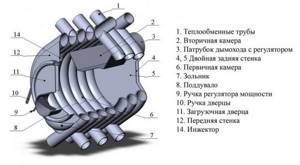
Schematic structure of the Buleryan furnace.
The location for the Buleryan stove is selected so that effective heating of the heated room is ensured.
In this case, care should be taken to ensure free access for cleaning and inspection. The floor under this device is made of non-combustible material.
Basic recommendations
Experts advise installing the buleryan on a metal stand, the height of which should exceed 20 cm. A brick base is allowed. The floor under the fire door should be protected with a metal sheet measuring 500x700 mm.
This stove operates due to the optimized fuel combustion process that occurs in it. Therefore, the operating rules for the stove provide strict requirements for the materials used for the construction of the chimney and its installation.
To ensure better circulation of air masses through the pipes, it is recommended to raise the stove 200 mm from the floor level, installing it on a base made of:
The Buleryan stove can be heated with almost any type of fuel except gaseous and liquid.
- slabs;
- bricks;
- stone;
- other non-combustible material.
Installation of this device involves the manufacture and installation of a 5 m chimney. For powerful models, you will need to make a 7 m chimney. This element is responsible for draft in smoldering mode. If this device smokes a little in gas generation mode, then there is not enough thrust.
The stove is installed at a distance of 60 cm from flammable materials. Before lighting the stove or putting wood in it, you should fully open the smoke damper and regulator. Next, the fuel is placed. After 20 minutes of burning, the stove switches to smoldering mode.
Installation work
The chimney is an important element of the Buleryan stove. The best option in this case is to install a heat-insulated chimney. This is due to the fact that the gases leaving the device have a low temperature. As a result, condensation forms. Insulated structures positively solve this problem. Households often prefer chimneys made of stainless steel with high heat resistance. Experts include the following advantages of this material:
- smooth surface;
- channel of optimal shape;
- high resistance to corrosion and temperatures;
- durability, low weight;
- easy installation.
Drawing of the Buleryan stove.
If the chimney is made of brick, then the thickness of its walls should be more than 120 mm. For concrete structures this figure is more than 60 mm, for metal structures - more than 1 mm. The chimney outlet is carried out on buildings with a roof made of non-hot material 1-1.5 m above the ridge. If this element is located inside the building, then it needs thermal insulation, which is carried out using mineral wool with a thickness of more than 200-250 mm.
In any case, horizontal sections longer than 1 m must be excluded. The diameter of chimneys should range between 120-150 mm. Experts do not recommend narrowing the diameter. If metal pipes are used, then their joints are sealed with non-flammable sealant.
At the base of this element there is a removable panel or hole with a door for cleaning. During the heating season, Buleryan is cleaned at least 2 times.
Construction of a chimney for a stove-stove
If you want to make a chimney for a potbelly stove with your own hands, prepare the following materials:
- tee;
- butt elbow;
- "fungus";
- knee, the size of which is 10 by 120 cm (1 pc.);
- knee measuring 16 by 120 cm (2 pcs.).
The installation of a chimney should begin by securing one of the pipe sections to the chimney pipe of the heating device. When the initial part of the chimney is securely fixed, the pipe is increased using the remaining sections and bends until the ceiling height is reached. Then a hole is cut in the ceiling, the minimum diameter of which is 160 mm. A so-called “pass-through glass” is passed into it and a pipe is passed, joining it with a ready-made external chimney. All cracks and joints are carefully treated with sealant or asbestos cord. The top of the stove's chimney is covered with a thick layer of heat insulation and bitumen. A protective canopy is installed above it.
Technical points
The chimney can be placed inside or outside the building. External installation is used when installing a heating unit in a ready-made house. This technique involves venting the chimney through the wall of the room.
Experts include the following advantages of this technique:
Design and operating features of the unit.
- significant space savings;
- quick and easy installation;
- there is no need to remove this unit through the interfloor ceiling and roof of the building.
The disadvantages include:
- presence of a horizontal section;
- carrying out thermal insulation work;
- unoriginal appearance.
The internal placement of the chimney involves the passage of its vertical sections of stainless pipe inside the building. In this case, the chimney is installed near the internal walls and partitions. It is discharged through the interfloor covering and the roof using special pipes and roof penetrations. To do this, you will need the following tools: hammer, hammer drill, drills, hammer.
Due to the low weight of stainless steel structures, installation work is carried out without installing an additional foundation. The difficulties of such a procedure include ensuring its safe passage through the ceiling, including a safe and sealed chimney exit through the roof.
Experts include the following advantages of this technique:
- presence of good traction;
- providing additional heat from the chimney itself.
The disadvantages of the internal placement of the chimney include:
- carrying out complex installation;
- occupied usable area;
- ensuring the tightness of the chimney passage through the roof;
- provision of additional fire safety measures when the chimney passes through the interfloor ceiling and roof.
A few nuances
The Buleryan stove is installed in a room whose floor, walls and ceiling are made of non-combustible materials. If they are present, you will need to apply thermal insulation, installing this device no closer than 1 m from walls and flammable surfaces such as wallpaper and wood. In this case, before firing the device, you will need to equip a free space with an area of more than 1.25 m.
It is allowed to reduce the distance from the Buleryan stove to flammable surfaces when using additional warm insulation according to the following scheme:
- up to 700 mm - when covering flammable materials with 25 mm thick plaster;
- up to 500 mm - when carrying out light insulation in 1 layer;
- up to 300 mm - when using double insulation from the 2 plates described above.
Instead of single light insulation, brickwork with a thickness of 55 or 110 mm is allowed - instead of double.
Unit design
The product is based on the design of a slow-burning steel convection-tube air boiler. Sometimes it is called a furnace-heater type device.
Buleryan consists of the following parts:
- Fireboxes. Heat exchangers are recessed into its walls by 2/3 of the diameter. In this case, 70% of the heat released in the firebox during smoldering is transferred from the air to the tubes. And 10% is distributed throughout the oven and heats the air.
- Doors that close tightly.
- Blower type pipe.
- Throttle. Using it, you can regulate the power of the device, and when it is closed, the oven goes out.
- Grate bars made of cast iron. When installing the product, they are placed below at a level slightly more than half of the firebox.
- Partitions located horizontally. It is welded from the top to a quarter of the height of the firebox and at the same time reaches the front side by a fifth of the entire size of the firebox. This jumper has holes with a total area of 7%.
Buleryan stove - long-burning design
The Buleryan boiler runs on any solid fuel (peat, firewood, sawdust, cardboard, paper, etc.), which makes it very practical and accessible to the population. It is not recommended to use coke, flammable liquids, or charcoal as fuel, as this can damage the boiler. This heating device is so safe to use that its installation is permitted even in fire hazardous areas such as garages and woodworking shops. Thanks to its unique design, the stove operates with incredibly high efficiency.
Principle of operation
Buleryan heats the room with streams of hot air, i.e. it works on the principle of a heater. Cold air is sucked into the oven through the lower pipes by convection. Since these same pipes pass through the firebox, the air instantly heats up to 120 degrees and forcefully comes out of the upper pipes.
Hot air quickly spreads throughout the room in which this device is installed. In the first compartment, the process of fuel combustion occurs with the subsequent release of furnace gases. The gas enters the upper chamber, where it burns out safely. Thanks to this, the Buleryan stove has a high efficiency (75-80%) and is completely environmentally safe, since all harmful gases are burned out inside it. A properly adjusted stove does not even emit smoke.
Fuel consumption is slow and economical. It is necessary to add fuel 2-3 times a day. A fully loaded firebox can supply heat evenly for 8-12 hours . The power regulator located on the door of the fuel chamber and the gasifier regulator located on the smoke pipe allow you to set the required temperature and control the process of heat release. The main part of the heat (90%) is released by streams of hot air through the upper pipes of the device, and only 10% is radiated by the stove itself. Therefore, its surface almost never gets hot.
Buleryan is a long-burning, volumetric stove, i.e. it is designed for a certain volume of the room in which it will be installed. The smallest stove in the Buleryan line is capable of producing 4.5 cubic meters of hot air per minute. Heating devices of this series have different sizes, depending on the thermal power and are designed to heat rooms with a volume of 100 to 1000 cubic meters. In terms of quality and efficiency, the Buleryan stove is far superior to traditional stoves and heaters that are expensive to install. Considering that the efficiency of a simple stove is only 3-7%, then using a Buleryan boiler will reduce your fuel costs by 10 times.
Furnace combustion modes:
- intensive;
- smoldering. This mode is the main one, since when the stove is used in intensive mode, the device wears out quickly and, as a result, the stove begins to consume fuel like an ordinary potbelly stove.
Advantages:
- autonomy, i.e. complete independence from external power sources (gas, electricity); high efficiency - 80% efficiency, uniform heating of the room, work on one load for up to 12 hours;
- large selection of models;
- ease of installation and maintenance;
- since the fuel burns out almost completely, it is recommended to clean the device only for preventive purposes;
- wide scope of application - private homes; cottages; country cottages; greenhouses; commercial, utility and industrial premises.
Flaws:
- Lack of a hob, i.e. it is impossible to cook food on such a stove;
- the Buleryan boiler requires constant loading, since it is completely devoid of inertia; when not in operation, it practically does not retain heat);
- unpresentable appearance. Although, if desired, it can be stylized with stones or some other home accessories;
- open combustion chamber. When the stove is operating, the air humidity in the room decreases, which can negatively affect people's well-being, so you should consider purchasing a humidifier.
Depending on the modification of the Buleryan stove, the price varies from 9,000 to 47,000.
The Buleryan boiler is made using the latest technology from thick high-quality steel and is practically resistant to burning.
Installation
When choosing a room to install a Buleryan stove, you should take into account that this device needs a constant supply of fresh air .
The location is determined taking into account the most efficient heating of the building. The stove is mounted on a stand, at least 20 cm high, made of non-flammable material (metal, brick, stone, etc.). A 0.5-0.7 m sheet of iron is placed on the floor near the fire door.
Installation and operation of Buleryan requires a chimney with a height of 5 m, and for more powerful models - 7 m. The best option is to install a heat-insulating chimney. This is explained by the fact that when leaving the device, the gases have a low temperature, as a result of which condensation forms. Thermal insulation of the chimney easily and successfully copes with this problem. Often homeowners install a stainless steel chimney with increased heat resistance.
The advantages of this material are as follows:
- Easy installation;
- light weight, durability;
- smooth surface;
- optimal channel shape;
- resistance to temperature changes and corrosion.
If a brick chimney is installed, the wall thickness should not be less than 12 cm. The diameter of the chimneys is 12-15 cm; it is not recommended to narrow it.
The distance from the device to flammable furnishings must be at least 0.6 m.
By installing Buleryan at home (at the dacha, in the garage), you will not only save your money, but also free yourself from all further costs for its maintenance.
Positive and negative aspects of the device
Breneran is a successful design that runs on solid fuel. It has many advantages:
- The housing serves as a forced convector through which all the oxygen in the room passes. In this case, air exchange is carried out naturally - due to the different densities of heated and cool air.
- You can burn peat briquettes, logs, waste from the paper and woodworking industries.
- High efficiency of the stove - it reaches 80%.
- Drawings of this heating device are widespread and can be found without much difficulty on the World Wide Web.
- The materials and equipment for installing the product are quite simple and are not very expensive. You will need a welding machine, a pipe bending device, metal sheets and stainless steel heat exchangers.
- The installation of the equipment itself, as well as the principle of its operation, is quite simple.
Disadvantages of the design
Buleryan has no visible negative sides. These devices are called “furnaces without flaws.” But if you understand the design well, you can still find negative aspects:
- Burning coal in a stove may damage the device. The use of flammable liquids and gases is also prohibited.
- The operating principle is based on the combustion of wood and paper. In this case, reaction water is released, which is formed during the breakdown of molecules of living organisms.
Sellers, when advertising breneran, say that when burning the tree does not form ash, but it is present in the wood initially. Therefore, ash particles fly into the chimney pipe.
When organic matter decomposes, hydrocarbon radicals are released, which reduce the efficiency of the stove by 6%. This is a small number, but radicals are quite dangerous for heating devices in everyday life.
The resulting water after the reaction precipitates as condensate. Moreover, this is not just a contaminated liquid, but a mixture of ash particles and a thin film rolled into a lump. The resulting toxins fall into the sump and have an unpleasant odor. This “water” always needs to be taken out somewhere, because it cannot be poured into the garden - otherwise the soil will be poisoned. In connection with this not very pleasant phenomenon, a heating device is often used in greenhouses, where the soil must be renewed annually.
How to install a Buleryan stove in the country?
“Here is part two about basic work at the dacha during vacation. This second part is devoted to the installation of the stove and chimney.
For almost six months I studied reviews on the Internet about the installation of various types of stoves and chimneys in dachas and country houses. After much thought, I came to the conclusion that Breneran (Buleryan) 01 is suitable for me. I also finally decided that I would install a chimney exclusively of the “sandwich” type.
The choice of model 01 was due to the fact that there are still uninsulated rooms in the house (non-residential for now), which means that more powerful heating will be required. Accordingly, I took it with a reserve of power (as, indeed, many recommend). The main thing was to find the most optimal place to locate the stove in the house. Such a place was found, and I began to calculate how exactly to route the chimney through the wall and how to generally choose the type of chimney.
After some time, I decided (with the help of consultations on the Internet) that this installation of the stove and the outlet of the chimney outside would be the most acceptable for me: https://foto.rambler.ru/public/meresiga/_photos/buler0/buler0- web.jpg I decided to install the stove and chimney myself while on vacation. Luckily there will be enough time and beer too. I also doubted for a long time whether I could unload the stove from the car myself, bringing it to the dacha after purchase. After all, the stove weighs a little more than 100 kg. However, everything went fine. When I bought the stove, they loaded it into the trunk of my Chevrolet Niva (after folding the seats and laying down the cardboard from the packaging box from under the refrigerator). And once there, I alone calmly pulled her out of there, lowered her to the ground, carried her home and installed her in her place.
